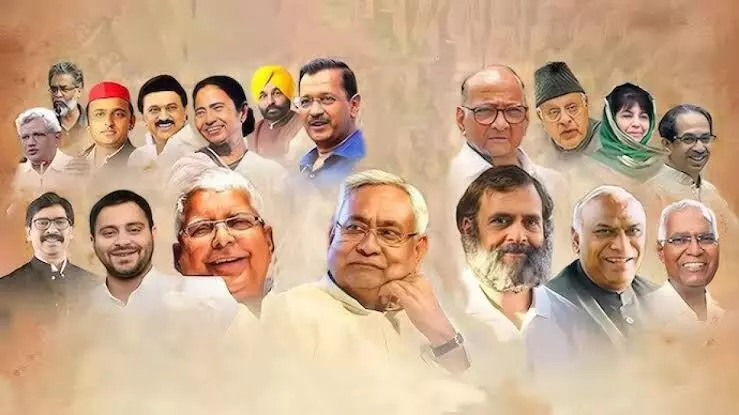The INDIA Alliance: A Coalition of Contradictions

The INDIA alliance, which once emerged as a formidable force against the Bharatiya Janata Party (BJP), is now grappling with its internal contradictions. While leaders like Kapil Sibal claim that the coalition will remain intact, the reality on the ground paints a different picture. The alliance, comprising regional parties with distinct aspirations, has consistently failed to offer a united front due to self-serving political agendas, particularly at the state level. The lack of cohesion among its members is evident, raising questions about its long-term viability.
A striking example of this contradiction is West Bengal Chief Minister Mamata Banerjee’s recent actions. Instead of strengthening the alliance, she chose to support Jan Chowdhury while sidelining Adhir Ranjan Chowdhury, the Leader of Opposition in Parliament. Mamata's Trinamool Congress (TMC) has repeatedly undermined the Congress party, either by contesting against it or by aggressively pushing its own candidates. Her decision to engage all resources in Bengal while bypassing Congress' role exemplifies the regional ambition that weakens the alliance's national standing. Despite calls for unity, TMC has always prioritized its state interests, making it clear that the INDIA bloc is more of an electoral calculation than an ideological commitment.
Another case in point is Arvind Kejriwal’s Aam Aadmi Party (AAP), which played a pivotal role in Congress’ decline in Punjab, Gujarat, and Delhi. While Congress agreed to support AAP in Delhi’s Rajya Sabha elections, AAP did not extend similar support during Assembly elections, leading to Congress' significant losses in multiple states. Kejriwal's political strategy has always been about expanding AAP’s footprint, even at the cost of the larger alliance. Now, as AAP faces setbacks due to corruption allegations, governance failures, and electoral losses, the party suddenly remembers the importance of the INDIA alliance. However, when Congress was at its weakest, AAP showed no such generosity. This selective unity exposes the transactional nature of the coalition.
A fundamental issue within the INDIA bloc is the position of Congress as the dominant player. Many regional parties are unwilling to acknowledge its leadership, fearing that it will overshadow their local relevance. The recent Assembly elections in Rajasthan, Madhya Pradesh, and Chhattisgarh demonstrated this dilemma clearly. Congress fought alone and lost badly, largely due to a lack of alliance cooperation. If the INDIA bloc was a true coalition, regional parties would have supported Congress in these crucial battles. But in states where they stood to gain, they chose to contest independently. This suggests that the regional satraps view Congress not as a partner, but as a competitor.
Electoral history also raises serious concerns about the genuineness of this opposition unity. In the 2019 Lok Sabha elections, Congress failed to build a strong opposition front in Uttar Pradesh, where Samajwadi Party (SP) and Bahujan Samaj Party (BSP) formed their own alliance. Congress was not included, leading to a fragmented anti-BJP vote. A similar situation is unfolding for 2024, with SP leader Akhilesh Yadav reluctant to concede seats to Congress. This exposes the fundamental weakness of the INDIA bloc: it is an alliance in name but a battlefield in practice.
Furthermore, in states like Bihar, Nitish Kumar has shifted allegiances so frequently that his commitment to any alliance remains questionable. His Janata Dal (United) [JD(U)] was with the BJP before switching to the INDIA bloc, and his history suggests that his association is more politically opportunistic than ideological.
The biggest flaw in the INDIA bloc is the competing interests of regional parties, which inherently contradict the unity narrative. Take Maharashtra, where Shiv Sena (Uddhav Balasaheb Thackeray faction) and the Nationalist Congress Party (Sharad Pawar faction) are struggling to balance their positions while competing against each other for dominance. If a party is fighting for regional control against another alliance partner, how can it be expected to present a united national front?
A similar issue exists in Tamil Nadu, where the Dravida Munnetra Kazhagam (DMK) is wary of Congress gaining strength in the state. Though DMK is a crucial INDIA bloc partner, its regional ambitions prevent it from making genuine space for Congress. The same pattern repeats in West Bengal, Delhi, Punjab, and even Karnataka, where Congress and the Janata Dal (Secular) [JD(S)] have long-standing rivalries despite occasional collaborations.
Despite these glaring issues, the opposition continuously claims to be united against the BJP. However, their actions suggest otherwise. The alliance is more focused on individual survival rather than a collective mission. The opposition leaders' public comments often contrast sharply with their electoral strategies, where they prioritize their own party’s success over alliance strength. The biggest irony is that even as they demand Congress' cooperation, they refuse to cede ground where it matters.
The BJP, under Prime Minister Narendra Modi, has successfully capitalized on these contradictions. It has strategically expanded its electoral base by targeting regions where the opposition remains fragmented. BJP’s ability to project a strong leadership, cohesive strategy, and clear vision stands in sharp contrast to the opposition’s internal battles and ideological contradictions. With Congress unable to assert its leadership and regional parties prioritizing local ambitions, the BJP’s dominance in national politics remains largely unchallenged.
Kapil Sibal’s confidence in the INDIA bloc’s unity appears to be more of a political statement than a reflection of reality. While opposition leaders may share a common goal of defeating the BJP, their actions suggest a reluctance to make real sacrifices for a united front. The alliance has yet to prove that it can function beyond convenience and overcome its internal rivalries. Unless these deep-rooted contradictions are resolved, the INDIA alliance risks becoming a fragile coalition held together only by electoral necessity rather than genuine political commitment.
The road to 2024 will be a litmus test for the opposition’s credibility. If they fail to prioritize collective strength over personal ambitions, the alliance will be nothing more than a patchwork coalition doomed to fail. As things stand, the INDIA bloc seems less like a cohesive opposition force and more like a collection of conflicting interests struggling for survival.
